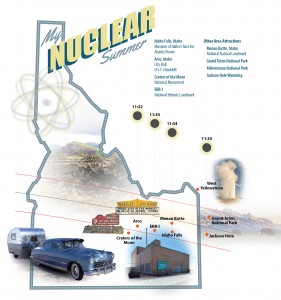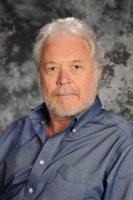Your Nuclear Summer Is Calling
By Paul Menser
 The sun is many things to many people, but from a scientific point of view, first and foremost, it's a great big nuclear reactor sitting out in space.
The sun is many things to many people, but from a scientific point of view, first and foremost, it's a great big nuclear reactor sitting out in space.
This is why we at Idaho National Laboratory are heralding 2017 as #yournuclearsummer. This year, an even greater number of tourists will be visiting the Greater Yellowstone Region, not just for the wonders of Yellowstone and Grand Teton National Park, but for the total eclipse of the sun, due to occur on Aug. 21.
But here's the deal: The eclipse starts at mid-morning and reaches full darkness around 11:30 a.m. In totality, it lasts two to three minutes tops. By 2 p.m., the sun will be shining, and the world will have returned to normal. You have traveled all this distance. What else is there to see?
For starters, there's Craters of the Moon National Monument, about two hours west of Idaho Falls. The monument was established in 1924 by President Calvin Coolidge and expanded in 2000 by President Bill Clinton. It encompasses three major lava fields and about 400 square miles of sagebrush steppe grasslands to cover a total area of 1,117 square miles. All three lava fields lie along the Great Rift of Idaho, with some of the best examples of open rift cracks in the world, including the deepest known on Earth at 800 feet. There are excellent examples of almost every variety of basaltic lava, as well as tree molds (cavities left by lava-incinerated trees), lava tubes (a type of cave), and many other volcanic features. The 60 distinct solidified lava flows that form the Craters of the Moon Lava Field range in age from 15,000 to just 2,000 years. The Kings Bowl and Wapi lava fields, both about 2,200 years old, are part of the National Preserve. Geologists consider the volcanic activity dormant, not extinct, with a high likelihood of resuming in the next 1,000 years.
Geologically, Craters of the Moon is a lot different from our actual moon, but that didn't stop NASA from sending the crew of Apollo 14 - Alan Shepard, Edgar Mitchell, Joe Engle and Eugene Cernan - to Idaho in 1969 for a field trip. The crew, all former test pilots, had little experience with geology, and since they would be collecting rocks on the moon to bring home (albeit in limited quantities), the planners at NASA decided it would be good for them to know enough to be able to spot the most scientifically interesting specimens. But NASA was not done with Craters of the Moon. In 2014, scientists from the Ames Research Center began a joint five-year study. The first project, FINESSE (Field Investigations to Enable Solar System Science and Exploration), is to conduct field experiments and procedures that may be used by astronauts if they ever visit Mars. The other, BASALT (Biologic Analog Science Associated with Lava Terrains) is to examine the habitability of terrains similar to Mars'.
Going from Idaho Falls to Craters of the Moon on U.S. Highway 20 will take you through the INL desert Site and Arco. It's a great time in #yournuclearsummer to visit Experimental Breeder Reactor I. Now decommissioned and a National Historic Landmark, EBR-I became one of the world's first electricity-generating nuclear power plants when it produced sufficient juice to illuminate four 200-watt light bulbs on Dec. 20, 1951. It was designated a National Historic Landmark by President Lyndon B. Johnson in 1966. At EBR-I's Atomic Museum, you can see three formerly functioning nuclear reactors, including two aircraft nuclear propulsion prototypes, and radiation detection equipment. Visitors can also try robotic arms used to handle radioactive materials. EBR-I is open 9 a.m. to 5 p.m. seven days a week from Memorial Day to Labor Day. No appointments are necessary and it is free of charge.
In the years it has been in existence, INL has been home at one time or another to 52 nuclear reactors. This year, the Advanced Test Reactor, the second-oldest of three reactors still in operation, marks its 50th anniversary. While it has been updated since its dedication in 1967, its function remains the same: to intensely bombard samples of materials and fuels with neutrons, simulating long-term exposure to high levels of radiation, as would be present in a commercial nuclear reactor. The ATR is one of only a handful of test reactors in the world with this capability. It also produces rare isotopes for use in medicine and industry. Learn more about group tours at INL.
The town closest to INL, Arco, bills itself as the first city ever to be lit by nuclear power. Its Idaho Science Center, staffed by retired INL engineers, is not hard to find. Nearby, you will find the 60-ton "sail" from the U.S.S. Hawkbill, a U.S. Navy submarine. What is a nuclear sub doing in the middle of the Idaho desert? Well, from the early 1950s to 1995 close to 40,000 U.S. Navy officers and sailors trained on prototype submarine and surface vessel reactors in Idaho. After it was decommissioned in 2001, the Hawkbill's sail was donated by the Naval Historical Society and brought to Arco on three separate trucks. Its number, "666," has inspired some to nickname it "Devil Boat," but nothing unfortunate ever happened in the more than 1.5 million ocean miles the Hawkbill covered while in service.
In Idaho Falls, you might want to visit the Museum of Idaho's "Race for Atomic Power" permanent exhibit. While the museum hosts world-class exhibits about everything from the R.M.S. Titanic to a T-Rex Named Sue, the permanent exhibits have a charm of their own. They're located in the museum wing that used to be the Idaho Falls Public Library, built in 1916 with help from the Carnegie Foundation. The "Race for Atomic Power" display includes a replica of one of the 200-watt bulbs lit by EBR-I, as well as graphite from that reactor. Funded in part by the Save America's Treasures Program, the exhibit was developed by the Atomic Heritage Foundation under a cooperative agreement with the Department of Energy-Idaho. Academy Studios of Novato, California, designed and fabricated the museum exhibits.
OK, but what about the Great American Eclipse? This will be the first to occur over the continental United States since 1979. It will happen roughly half an hour before noon, in T-shirt-and-flip-flop weather (unlike the 1979 eclipse, which happened in February and was only observable in Oregon, Washington, Idaho and Montana before it headed north into Canada).
From the Sawtooths to the Tetons, we can expect spectacular landscapes bathed in eerie light for two hours as the moon slides in front of the sun. This will be capped by roughly two minutes of totality, at which point a shadow will slide across the surface of the land at 1,800 miles an hour, and the lid of darkness will reduce the sun to a ring of fire in the sky. This is more than "gee whiz" stuff; it is a genuinely primordial brain scrambler. Even with science and astronomy in their corner, people have been known to react with tears and screaming.
Yellowstone National Park lies just outside the edge of totality, but Jackson Hole promises to be one of the best places to view the event. On the centerline "sweet spot," the Tetons will experience two minutes and 20 seconds of totality at roughly 11:35 a.m.
On the Idaho side of the Tetons, there are plenty of prime spots for viewing the show. We suggest a few:
Grand Targhee Ski Resort (Alta, Wyoming): If you can manage to get a ride on the Dreamcatcher chairlift to the top of Fred's Mountain, you will get a spectacular view of the Teton Range to the east as the moon passes in front of the sun. Expect a crowd.
North Menan Butte (Menan, Idaho): The North and South Menan Buttes are two of the world's largest volcanic tuff cones. South Menan Butte is in private hands, but North Menan Butte (elevation 5,619 feet) has been designated as a National Natural Landmark and features a BLM hiking trail to the top. Totality starts at 11:32:54 a.m. and will last two minutes and 17 seconds.
Last of all, for the #yournuclearsummer diehards, EBR-I is in the area of totality, so it might be a neat place to watch the sun go dark, on the wide open sagebrush desert with the Big Southern Butte nearby. Totality is scheduled for 11:31 a.m. and due to last 68 seconds.
 Paul Menser is a senior science writer for North Wind Group in Idaho Falls, working under contract for Idaho National Laboratory. From 1981 to 2008 he was a writer and editor at the Idaho Falls Post Register, for which he still writes a weekly history column. He is the author of "Legendary Locals of Idaho Falls," released in 2015 by Arcadia Publishing.
Paul Menser is a senior science writer for North Wind Group in Idaho Falls, working under contract for Idaho National Laboratory. From 1981 to 2008 he was a writer and editor at the Idaho Falls Post Register, for which he still writes a weekly history column. He is the author of "Legendary Locals of Idaho Falls," released in 2015 by Arcadia Publishing.

